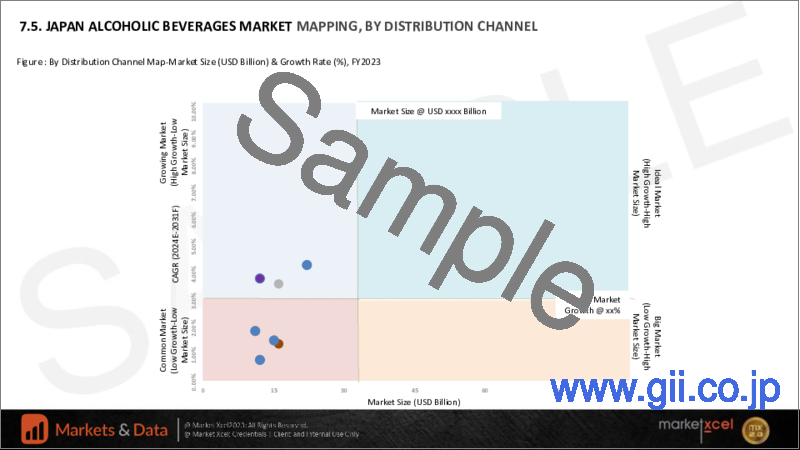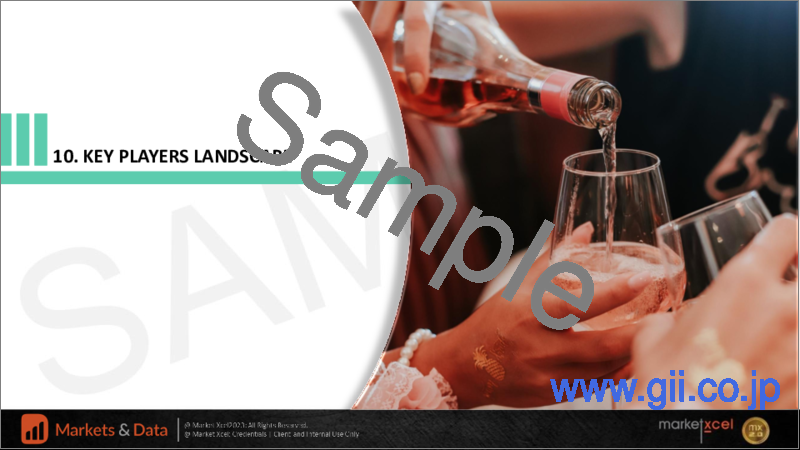|
|
市場調査レポート
商品コード
1532136
日本のアルコール飲料市場:タイプ別、アルコール度数別、パッケージ別、カテゴリー別、流通チャネル別、地域別、機会、予測、2017年~2031年Japan Alcoholic Beverages Market Assessment, By Type, By Alcohol Content, By Packaging, By Category, By Distribution Channel, By Region, Opportunities, and Forecast, FY2017-FY2031F |
||||||
カスタマイズ可能
|
|||||||
| 日本のアルコール飲料市場:タイプ別、アルコール度数別、パッケージ別、カテゴリー別、流通チャネル別、地域別、機会、予測、2017年~2031年 |
|
出版日: 2024年08月13日
発行: Markets & Data
ページ情報: 英文 103 Pages
納期: 3~5営業日
|
全表示
- 概要
- 図表
- 目次
日本のアルコール飲料の市場規模は、2023年に816億2,000万米ドルとなりました。同市場は、2031年には988億3,000万米ドルに達すると予測されています。予測期間の2024年~2031年のCAGRは2.42%とみられています。いくつかの社会的・経済的要因が日本のアルコール消費量に影響を与えています。伝統的なアルコール飲料が復活し、さまざまな地域に応じて調整され、日本全土の消費パターンに影響を与えています。
日本の飲酒適齢期は20歳です。日本では社交的な飲酒が重要な意味を持ち、社会的なつながりやビジネス上のつながりを育む手段となっています。また、日本では家庭でアルコールを消費するのが普通です。親族やビジネスパートナーにお酒を贈る習慣も、日本におけるアルコール飲料の需要を促進する重要な側面です。日本のアルコール飲料市場は、ビール、発泡酒、新ジャンルビール、日本酒、焼酎、チューハイ、梅酒、ワイン、リキュール、ウイスキーハイボールなど、さまざまな飲料で構成されています。
これらの拡大パターンは、消費者の嗜好の変化、健康や品質に対する意識の高まり、個性的でオリジナリティのある体験への渇望を表しています。こうした動向は、日本のアルコール飲料市場で事業を展開する他の参入企業に、絶え間なく変化する消費者ニーズを満たしながら事業を成長させる機会を提供するとみられています。
当レポートでは、日本のアルコール飲料市場について調査し、市場の概要とともに、タイプ別、アルコール度数別、パッケージ別、カテゴリー別、流通チャネル別、地域別動向、および市場に参入する企業のプロファイルなどを提供しています。
目次
第1章 調査手法
第2章 プロジェクトの範囲と定義
第3章 COVID-19が日本のアルコール飲料市場に与える影響
第4章 エグゼクティブサマリー
第5章 顧客の声
第6章 日本のアルコール飲料市場の見通し、2017年~2031年
- 市場規模と予測
- タイプ別
- アルコール度数別
- パッケージ別
- カテゴリー別
- 流通チャネル別
- 地域別
- 企業別市場シェア(%)、2023年
第7章 市場マッピング、2023年
第8章 マクロ環境と産業構造
- 供給需要分析
- 輸出入分析
- バリューチェーン分析
- PESTEL分析
- ポーターのファイブフォース分析
第9章 市場力学
第10章 主要参入企業の情勢
第11章 価格分析
第12章 ケーススタディ
第13章 主要参入企業の見通し
- Suntory Holdings Limited
- Kirin Holdings Company, Limited
- Asahi Group Holdings Limited
- Takara Holdings Inc.
- Sapporo Holdings Ltd
- OENON Holdings, Inc.
- Gekkeikan Sake Co., Ltd.
- Choya Umeshu Co., Ltd.
- Ozeki Corporation
- Sanwa Shurui Co., Ltd.
第14章 戦略的提言
第15章 お問い合わせと免責事項
List of Tables
- Table 01: Import Data, 2019-2023
- Table 02: Export Data, 2019-2023
- Table 03: Japan Alcoholic Beverages Market - Competition Matrix of Leading Companies
- Table 04: Pricing Analysis, Average Selling Price (In USD per 750 ml)
List of Figures
- Figure 01: Respondents, By Profession
- Figure 02: Respondents, By Location
- Figure 03: Respondents, By Gender
- Figure 04: Respondents, By Age
- Figure 05: By Common Places Where People Enjoy Alcohol (%)
- Figure 06: By Frequency of Drink (%)
- Figure 07: By Type of Alcohol (%)
- Figure 08: By Key Attributes Considered While Purchasing (%)
- Figure 09: By Preferred Alcohol Content (%)
- Figure 10: By Preferred Brand (%)
- Figure 11: By Consumer Satisfaction (%)
- Figure 12: Japan Alcoholic Beverages Market, By Value, In USD Billion, FY2017-FY2031F
- Figure 13: Japan Alcoholic Beverages Market, By Volume, In Million Cases, FY2017-FY2031F
- Figure 14: Japan Alcoholic Beverages Market Share, By Type, By Value Share, FY2017-FY2031F
- Figure 15: Japan Alcoholic Beverages Market Share, By Alcohol Content, By Value Share, FY2017-FY2031F
- Figure 16: Japan Alcoholic Beverages Market Share, By Packaging, By Value Share, FY2017-FY2031F
- Figure 17: Japan Alcoholic Beverages Market Share, By Category, By Value Share, FY2017-FY2031F
- Figure 18: Japan Alcoholic Beverages Market Share, By Distribution Channel, By Value Share, FY2017-FY2031F
- Figure 19: Japan Alcoholic Beverages Market Share, By Region, By Value Share, FY2017-FY2031F
- Figure 20: Market Share of Top Five Companies (FY2023)
- Figure 21: By Type Map-Market Size (USD Billion, FY2023) & Growth Rate (%, FY2024E-FY2031F)
- Figure 22: By Alcohol Content Map-Market Size (USD Billion, FY2023) & Growth Rate (%, FY2024E-FY2031F)
- Figure 23: By Packaging Map-Market Size (USD Billion, FY2023) & Growth Rate (%, FY2024E-FY2031F)
- Figure 24: By Category Map-Market Size (USD Billion, FY2023) & Growth Rate (%, FY2024E-FY2031F)
- Figure 25: By Distribution Channel Map-Market Size (USD Billion, FY2023) & Growth Rate (%, FY2024E-FY2031F)
- Figure 26: By Region Map-Market Size (USD Billion, FY2023) & Growth Rate (%, FY2024E-FY2031F)
- Figure 27: Total Group Revenue of Top Five Players, in USD Billion, FY2023
Japan alcoholic beverages market was estimated at USD 81.62 billion in FY2023 and is anticipated to reach USD 98.83 billion by FY2031. The market is projected to witness a CAGR of 2.42% during the forecast period FY2024-2031. Several social and economic factors affect the quantity of alcohol consumed in Japan. Traditional alcoholic drinks have been revived and tailored according to different geographical regions, impacting the consumption patterns across Japan.
The legal age for drinking in Japan is 20 years. Social drinking holds a significance in Japan, serving a means to foster social and business connections. Also, it is usual for Japanese households to consume alcohol at home. The Japanese custom of presenting gifts associated with alcohol to relatives and business partners on different occasions is another significant aspect that drive demand for alcoholic beverages in the country. The market for alcoholic drinks in Japan consists of various beers, including beer, Happoshu, a low-malt beverage with similar alcohol content to beer, New Genre Beer that is a malt-free beer, Sake or Nihonshu, which is rice wine, Shochu, a distilled spirit made from rice, sweet potatoes, wheat, and/or sugar canes, Chuhai, a fruit-flavored alcoholic beverage made from shochu and water, plum wine, wine, liquors, and whiskey highball.
The patterns of expansion depict changing tastes among consumers, rising consciousness on health and quality issues, and a craving for distinctiveness and originality in terms of experiences. These trends will offer other players operating in the Japanese alcohol beverages market an opportunity to grow their businesses and meeting the constantly changing consumer needs.
Shifting Demographics Influence the Market Growth
Japan is witnessing a huge transition in its demography. The state of old age in the country affects the alcoholic beverages market to a great extent. Japan has one of the highest life expectancies around the globe coupled with a dip in death rates, hence creating a community that is growing older rapidly. This demographic pattern presents several social, economic, and cultural issues for the nation. The growing number of senior citizens will result in an increased need for products and services which meet their particular demands, including alcoholic drinks. Due to the senior populace growing more mindful of their well-being, they are moving from alcoholic beverages with higher ABV content to other safer alternatives such as low-alcohol drinks. Following the trend, some producers have made beverages such as light weight beers, targeting this demographic group. For instance, in July 2024, a new craft beer, Small Trip, was introduced by REVO BREWING, a company located in Yokohama. The saison-style artisan beer has an extremely low 2.5% alcohol percentage, with overtones of citrus and spice.
Moreover, consumer behavior and preferences are affected by the elderly population. Senior customers mostly focus on their health and wellbeing, which causes new trends for producing healthier alcoholic drinks such as low-calorie beverages or those without additives. Producing firms and sellers are trying to make more varieties available for increasingly aging individuals' tastes.
Traditional and Craft Beverages Drive Market Demand
In Japan, various drinks including Sake, Shochu, and Plum Wine are deeply rooted in the way of life and customs of its population. People enjoy drinking these beverages, representing their deeply embedded significance into the country's heritage. This explains why people still consume and appreciate traditional drinks enhancing their market growth.
The recent trend in the consumption of craft beverages including Craft Beer, Whisky, and Sake has been growing. Consumers are increasingly searching for unique high-quality products that stand out with their distinct tastes and features. Brewed by independent and smaller breweries or distilleries, craft drinks present a unique and premium segment that appeals to consumers with refined tastes.
Traditional production methods, local and high-quality ingredients are often emphasized in these drinks. Consumers appreciate this emphasis on authenticity and traceability as it makes them aware of the origin and production process of the beverage that they prefer consuming.
In June 2022, Bira 91, a beer brand, collaborated with Japan's Far Yeast Brewing Company and introduced their inaugural Gose-style beer, Yuzu Gose Sour. Typically, a Gose-style beer originates from Germany and is characterized by its low hop bitterness and utilization of wheat in the brewing process.
Government Regulations to Boost Market Demand
The taxation policies of Japan have experienced numerous alterations over decades, changing according to the alcohol by volume (ABV) of various drinks. A recent development of 2022 was government outlined plan to implement a gradual transition in tax rates. The intention was to lower the taxes on sake and beer, but at the same time elevate taxes on low malt beers, Chuhai, which is a cocktail drink with an ABV of less than 12%, and wine. Such tax changes would help create a more equitable taxation system that relates to the distinctive features of every beverage category.
The authorities are taking these measures to alleviate inequalities in taxation, thereby ensuring a standardized method of collecting revenue from alcoholic drinks sold throughout Japan. To guarantee that the licensing specifications are fulfilled and illegal transaction are avoided, the authorities support sanity practices, circulation, and marketing of intoxicating drinks. This encompasses prohibitions on distributing alcohol to underage people, limitations on overtime of operating shops, and fines for non-compliance.
Internet Retailing Emerging as a Significant Distribution Channel
The alcoholic beverages industry has experienced many companies moving beyond the conventional sales points such as bars and restaurants to online platforms. This change has remarkably benefitted well-established online dealers such as Shinanoya, who are famous for their niche whiskies. Until 2020, was an important avenue for e-commerce, which had an observed increase of 7% share among other alcoholic markets, but whisky was at the forefront with 30% growth. The shift suggests that there is a significant shift in the way Japanese individuals consume alcoholic drinks as they prefer online shopping sites, where they enjoy more alternatives and convenience, rather than traditional channels. Large companies in the alcoholic beverages industry have taken advantage of this change by creating partnerships with big e-commerce companies such as Amazon.com, Inc. and Rakuten Group, Inc.
Impact of COVID-19
Japanese alcoholic beverages industry was significantly impacted by COVID-19. On-premise consumption went down due to the restrictions on restaurants and social aspects which used to facilitate consumption of drinks outside homes. It led to a loss of customers for mainly craft breweries and small producers due to decreased footfalls and limited means of transport. The Ministry of Internal Affairs and Communications had an apparent expenditure decline in restaurants' alcohol consumption with a year-on-year decrease of 52.7%, main reasons being restricted hours and reduction in availability. Consequently, spending on alcohol at home increased with individuals turning towards home drinking during lockdowns.
Furthermore, interruptions in international supply chains influenced access to specific foreign items. Customers switched to high priced and quality drinks at home. COVID-19 expanded the role of e-commerce platforms as main conduits for consumers. The market has evolved post-pandemic with shifting consumer tastes and preferences.
Key Players Landscape and Outlook
The alcoholic beverages market in Japan is well-established and highly competitive. Therefore, companies aiming to enter this market must offer appealing products and an effective marketing strategy. It is crucial to set the right pricing, implement robust business controls, maintain reliable communication channels, and ensure timely production and delivery of products.
A growing health trend has emerged, increasing market share for low-malt and alcohol and calorie-free beers. Embracing and catering to this trend can enhance the chances of success in the Japanese market. In July 2022, the Suntory Group took a significant step towards streamlining its domestic liquor operations and adapting to evolving alcohol consumption patterns by establishing a new domestic liquor company. This new entity, Suntory Spirits Limited, was formed by merging five pre-existing companies.
Table of Contents
1. Research Methodology
2. Project Scope and Definitions
3. Impact of COVID-19 on Japan Alcoholic Beverages Market
4. Executive Summary
5. Voice of Customer
6. Japan Alcoholic Beverages Market Outlook, FY2017-FY2031F
- 6.1. Market Size & Forecast
- 6.1.1. By Value
- 6.1.2. By Volume
- 6.2. By Type
- 6.2.1. Beer
- 6.2.2. Wine
- 6.2.3. Spirits
- 6.2.4. Ciders and Flavored Alcoholic Beverages (FABs)
- 6.2.5. Others
- 6.3. By Alcohol Content
- 6.3.1. High
- 6.3.2. Medium
- 6.3.3. Low
- 6.4. By Packaging
- 6.4.1. Aluminum Cans/Tins
- 6.4.2. Glass Bottles
- 6.4.3. Plastic Bottles
- 6.4.4. Others
- 6.5. By Category
- 6.5.1. Mass
- 6.5.2. Premium
- 6.6. By Distribution Channel
- 6.6.1. Convenience Stores
- 6.6.2. On-Premises
- 6.6.3. Liquor Stores
- 6.6.4. Grocery Shops
- 6.6.5. Internet Retailing
- 6.6.6. Supermarkets
- 6.6.7. Others
- 6.7. By Region
- 6.7.1. North
- 6.7.2. East
- 6.7.3. West and Central
- 6.7.4. South
- 6.8. By Company Market Share (%), FY2023
7. Market Mapping, FY2023
- 7.1. By Type
- 7.2. By Alcohol Content
- 7.3. By Packaging
- 7.4. By Category
- 7.5. By Distribution Channel
- 7.6. By Region
8. Macro Environment and Industry Structure
- 8.1. Supply Demand Analysis
- 8.2. Import Export Analysis
- 8.3. Value Chain Analysis
- 8.4. PESTEL Analysis
- 8.4.1. Political Factors
- 8.4.2. Economic System
- 8.4.3. Social Implications
- 8.4.4. Technological Advancements
- 8.4.5. Environmental Impacts
- 8.4.6. Legal Compliances and Regulatory Policies (Statutory Bodies Included)
- 8.5. Porter's Five Forces Analysis
- 8.5.1. Supplier Power
- 8.5.2. Buyer Power
- 8.5.3. Substitution Threat
- 8.5.4. Threat from New Entrant
- 8.5.5. Competitive Rivalry
9. Market Dynamics
- 9.1. Growth Drivers
- 9.2. Growth Inhibitors (Challenges and Restraints)
10. Key Players Landscape
- 10.1. Competition Matrix of Top Five Market Leaders
- 10.2. Market Revenue Analysis of Top Five Market Leaders (By Value, FY2023)
- 10.3. SWOT Analysis (For Five Market Players)
11. Pricing Analysis
12. Case Study
13. Key Players Outlook
- 13.1. Suntory Holdings Limited
- 13.1.1. Company Details
- 13.1.2. Key Management Personnel
- 13.1.3. Products and Services
- 13.1.4. Financials (As Reported)
- 13.1.5. Key Market Focus and Geographical Presence
- 13.1.6. Recent Developments
- 13.2. Kirin Holdings Company, Limited
- 13.3. Asahi Group Holdings Limited
- 13.4. Takara Holdings Inc.
- 13.5. Sapporo Holdings Ltd
- 13.6. OENON Holdings, Inc.
- 13.7. Gekkeikan Sake Co., Ltd.
- 13.8. Choya Umeshu Co., Ltd.
- 13.9. Ozeki Corporation
- 13.10. Sanwa Shurui Co., Ltd.





